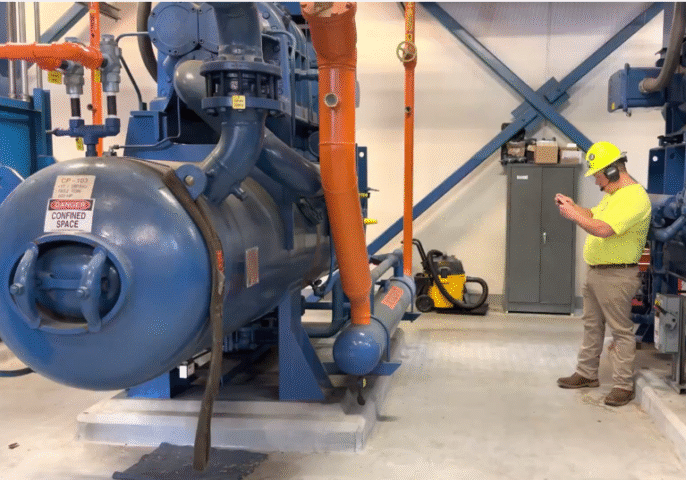Achieving the Certified Industrial Refrigeration Operator (CIRO) certification is a significant milestone for professionals in the ammonia refrigeration industry. This certification demonstrates advanced expertise in operating, maintaining, and troubleshooting industrial refrigeration systems while adhering to safety and regulatory standards. Whether you’re advancing from CARO certification or already have years of experience, this guide will help you navigate the process of becoming CIRO certified.
How Do You Become a CIRO?
1. Understand What CIRO Certification Is
The CIRO certification is offered by the Refrigerating Engineers & Technicians Association (RETA). It’s designed for individuals with substantial experience in ammonia refrigeration who want to enhance their skills, validate their knowledge, and take on more advanced roles within the industry.
What CIRO Covers:
- Advanced system operations and maintenance.
- Troubleshooting complex refrigeration issues.
- Compliance with OSHA’s Process Safety Management (PSM) standards.
- Emergency response and safety protocols.
- System design and energy efficiency optimization.
2. Assess Your Eligibility
Unlike CARO, CIRO is intended for experienced operators. Before pursuing certification, ensure you meet these prerequisites:
- Experience: A minimum of 2-3 years of hands-on experience working with industrial refrigeration systems is highly recommended.
- Foundational Knowledge: While not mandatory, having CARO certification provides a strong foundation and helps prepare you for the advanced concepts covered in CIRO.
- Regulatory Knowledge: Familiarity with OSHA and EPA standards, such as PSM and RMP (Risk Management Plan), is critical.
If you meet these requirements, you’re ready to start the process of becoming CIRO certified.
3. Enroll in a CIRO Training Program
Training is essential to prepare for the CIRO certification exam. Enroll in a RETA-approved program to ensure you’re receiving the most relevant and up-to-date training.
Types of Training Available:
Online Courses: These are ideal for busy professionals who need flexibility. They often include video tutorials, interactive sessions, and practice exams.
In-Person Classes: Hands-on training provides real-world experience, often involving live ammonia refrigeration systems.
Hybrid Programs: A combination of online and in-person training to suit various learning preferences.
Key Topics Covered in Training:
- Advanced refrigeration principles.
- System performance analysis and optimization.
- Emergency response planning.
- Troubleshooting system failures.
- Compliance with industry regulations.
4. Study the Recommended Materials
RETA provides study materials specifically designed for CIRO candidates. Some key resources include:
- Industrial Refrigeration II Textbook: This is a must-read, covering advanced principles and applications.
- Practice Exams: These simulate the actual test and help you identify areas where you need improvement.
- RETA Resources: Access additional study guides, technical papers, and webinars through RETA.
Consistency is key. Dedicate time each week to studying these materials to build confidence and deepen your understanding.
5. Prepare for the CIRO Exam
The CIRO certification exam tests your ability to apply advanced knowledge and solve real-world problems. Here’s what to expect:
Exam Format:
- Type: Multiple-choice questions.
- Length: 150 questions.
- Time Limit: 3 hours.
- Topics Covered: Refrigeration operations, system troubleshooting, compliance, and safety protocols.
Tips for Success:
Practice: Complete practice exams to familiarize yourself with the question format.
Review Key Concepts: Focus on areas where you feel less confident, such as troubleshooting or regulatory compliance.
Stay Relaxed: Arrive early, stay focused, and manage your time carefully during the exam.
6. Pass the CIRO Exam and Earn Certification
Once you pass the exam, you’ll receive your CIRO certification. This credential demonstrates your ability to handle advanced responsibilities in industrial refrigeration and is highly valued by employers in the industry.
Benefits of CIRO Certification:
- Career Advancement: Qualify for higher-paying roles like senior operator, supervisor, or compliance manager.
- Industry Recognition: Stand out as a certified expert in industrial refrigeration.
- Enhanced Safety Skills: Gain advanced knowledge to ensure the safety of your team and facility.
7. Maintain and Renew Your Certification
CIRO certification requires periodic renewal to ensure you stay up-to-date with industry standards and regulations. Here’s how to maintain your certification:
- Continuing Education: Complete additional training or workshops to earn renewal credits.
- Work Experience: Document your ongoing experience in ammonia refrigeration.
- Stay Current: Keep up with updates to OSHA, EPA, and IIAR standards to ensure compliance.
Why CIRO Certification Matters
Earning CIRO certification not only boosts your career but also strengthens workplace safety and compliance. As ammonia refrigeration systems become more advanced, employers seek certified professionals who can manage them efficiently while minimizing risks. By becoming a CIRO, you position yourself as a leader in the industry, capable of tackling complex challenges and ensuring operational excellence.
Take the Next Step Toward CIRO Certification
Becoming a CIRO is a rewarding investment in your professional future. Start by assessing your eligibility, enrolling in a training program, and dedicating time to thorough exam preparation. With the right resources and commitment, you’ll achieve certification and unlock new opportunities in the ammonia refrigeration industry. Ready to take the next step? Begin your journey today by exploring RETA-approved training programs and resources.


